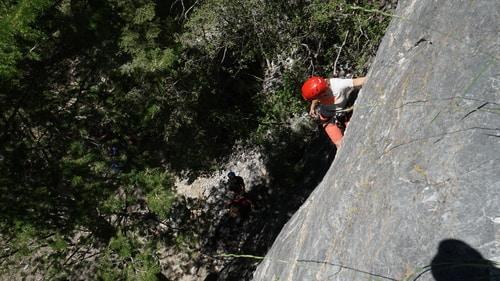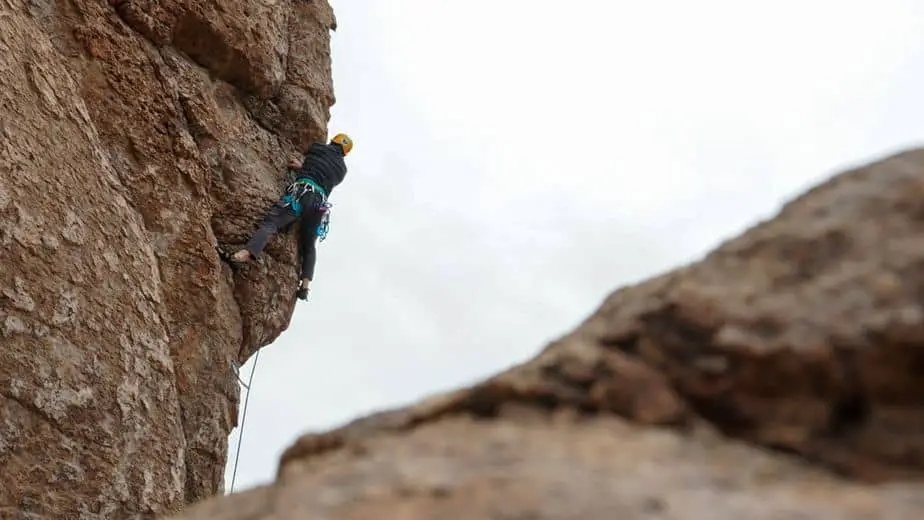There are a lot of terms in rock climbing that sound pretty similar, which can be confusing for beginners and more advanced climbers alike. Some of them overlap as well, which adds to the confusion.
Sport climbing is a form of lead climbing where the climber brings the rope up from the ground and only uses fixed gear for protection to keep from falling very far. Lead climbing also refers to Trad (Traditional) climbing, which uses gear that is not permanent.
Sport climbing is lead climbing, but lead climbing is not always sport climbing. Here are some of the key differences between different kinds of sport climbing, followed by some essential tips for sport climbing-
Sport Climbing v Lead Climbing
Most climbers start out their lifelong climbing addiction by either climbing in a climbing gym or going outdoors with a friend and mentor. The first few times you go you will be more worried about falling to the ground than about whether or not you are top-roping, sport climbing, or trad climbing.
Lead Climbing: Sport Climbing
In a climbing gym most of the walls are dedicated to top rope climbing. This is for many reasons, but primarily because gym climbers are there for exercise and entertainment. It’s just fun to zip up and down routes of all difficulties for a couple of hours.
They aren’t interested in taking nasty falls or wearing out their expensive ropes. Additionally, gyms are full of people just getting into the sport who don’t have a lot of experience.

Lead Climbing in a Gym
If I had to guess, I’d say that fewer than 1 in 100 climbers in a gym takes advantage of the lead climbing walls. You can always identify the lead climbing walls immediately because that’s where there’s a big gap.
Top rope routes are lined with people, but then there’s usually only one or two pairs in the lead area. Lead climbing is a lot more tiring than top rope climbing, and usually takes a lot longer. This can mean you’re spent after a handful of routes.
In a climbing gym, the quickdraws are fixed to the wall. This means that all you have to do as you climb is reach down, grab the rope, pull it up, and clip it into the draw. While this is sport climbing, it simplifies the process and makes it a little bit easier because you don’t have to clip the draw onto the bolt hanger first.
Leading indoors is a great way to practice clipping the rope into the quickdraws while precariously positioned, and a great way to practice taking falls without getting hurt. Climbing up above the protection takes a lot more mental fortitude than climbing top rope.
Additionally, and maybe even more importantly, it is a great place to practice belaying a lead climber in a much safer environment than when climbing outside. When belaying a leader you have to fluidly switch between paying out slack and taking it in.
When you first start out, you’ll hear a lot of frantic yells of “Take!!” followed by even more frantic “Slack!!” and back and forth over and over again. As you keep practicing, you learn to provide the right balance of support throughout the route and get to the point where you can tell what your climber needs before they say it.
Lead Climbing Outside
A lot of people learn to top rope climb inside, then learn to top rope climb outside, only starting to lead out of necessity when they can’t find a stronger partner to climb with or when their schedules don’t align. Climbing outside is the big leagues. Risks are higher, but so are the rewards.
The main difference initially is that the route isn’t color-coordinated so you don’t immediately see where to go. In addition to figuring out how to move in order to get to the next hold, you also need to find where that hold is.
The line of bolts up the wall help with this, but sometimes you have to look for a long time before finding the little divot in the wall that might hold your toe for long enough for you to stretch to the handhold up above.
The holds aren’t bolted onto the wall, so be wary as you trust anything. It’s not uncommon (especially in Arizona where I live) for climbers to break holds off of the walls. Try not to hurl anything down at your belayer (and Always Wear a Helmet!).
The belayer should be ready for a fall at all times, and should plan it out before it happens. Make sure you won’t get smashed into the wall if the climber falls, and clear the area of any tripping hazards if possible. Try to stay close to the wall so that you aren’t jerked over into it.
For a comprehensive look at climbing indoors versus outdoors, read this article: Indoor versus Outdoor Climbing: What you Need to Know.

Competition Climbing v Sport Climbing
Some people confuse Sport Climbing with Competition Climbing. Many climbing competitions incorporate sport climbing (lead climbing), but the vast majority of sport climbers never participate in organized competitions.
Competitive climbing is growing in popularity, and the format is still being set in stone. Most competitions include a bouldering portion and a lead climbing (sport) portion. Some also include speed climbing.
Lead Climbing: Trad Climbing
The term Lead Climbing can also refer to Trad Climbing. The principles are the same- climbers clip the rope to points along the ascent to arrest their fall if they take a whipper.
The difference is that sport climbing uses permanent bolts and trad uses removable cams and nuts. When placed properly, they can be just as strong as bolts (or at least plenty strong enough).
The advantage to trad climbing is that it can be done without permanently leaving a mark on the wall. It is more dangerous than sport climbing because the gear isn’t bolted into the wall. Because of this, it’s a lot less popular than sport climbing.
Trad climbing can only be done on rock outside (if there are any indoor trad gyms in the world, let me know!). The gear costs significantly more than sport climbing costs (3-5x the price).
Tips for Sport Climbing Lead Climbing
Here are a few things that you should make an effort to learn and practice if you start Sport Lead Climbing.
Communicate
I remember during my first multi-pitch route several years ago there was some wind that was interfering with the communication between me and the climber below me. She kept yelling “TAKE!!” because she was just about to make a difficult committed move. From my vantage point at the belay station 75 feet up, it sounded like she was yelling my name, “JAKE!!” I kept answering her with “What?”
She was pretty frustrated when she got up to me that I hadn’t kept the rope as taut as she’d wanted, but we both had a good laugh when we figured out what happened (and we’ve come a long way since then!).
If communication is key to a successful romantic partnership, then it’s got to be at least as important to a successful climber-belayer partnership. Make sure to establish key commands before the climber even clips the first draw- are you going to use “Take” and “Slack” and “Clipping?” Will you say “Off belay” and “On Rappel”? On an especially long route or if there is a lot of ambient noise, maybe you can use tugs on the rope to communicate instead.
Another crucial communication key is to always decide ahead of time whether the climber will rappel down or will be lowered down. Many serious accidents have happened when the climber reaches the top, sets the anchor, and then leans back on the rope to be lowered only to find out that the belayer had disconnected and stepped away. Decide before you even leave the ground.
Practice Clipping Quickdraws
There is nothing worse than clinging to the wall by a fingertip while you’re fumbling with the rope trying to get it into the quickdraw. Your sewing machine leg starts going, your breathing accelerates, and your whole body starts shaking (which does nothing to help your task!).
Practice clipping the rope into quickdraws until it becomes second nature. One thing that can help is to clip a draw to the rearview mirror in your car and practice clipping a rope through it while you’re stuck at traffic lights. Over time you get a feel for it and it becomes a lot easier.
Know What Not to Do
Sport climbing is a little bit more complicated than it seems at first, and there are a few things you need to avoid doing in order to prevent accidents.
- Always make sure that the carabiner is fully through the bolt hanger, not stuck on the nose. The nose of a carabiner is not strong enough to catch a falling climber.
- Clip the draw so that the carabiner on the rope side faces away from the direction of the route. This will make it so the gate faces out away from the wall instead of in towards it. A gate facing the wall could theoretically come open when pushed against the rock.
- Make sure you don’t Back Clip or Z-Clip the rope. This happens when a route is bolted very close together and you grab the rope from below the previous quick draw and clip it into the one above. The rope goes up to a bolt, and then back down again and back up. This adds a lot of additional friction and opposing forces into the system, and can cause the middle draw to come undone.
- Don’t top rope on fixed gear. It’s hard to believe, but ropes can wear through aluminum bolt hangers, rappel rings, and quick links over a fairly short amount of time, especially in places that see a lot of climbing traffic. Create your own anchor by clipping your own quick draws or locking carabiners onto the anchors so that you wear through your own gear instead of the communal gear. Rappel down instead of lowering whenever possible.
Conclusion
Lead climbing is how climbers get the rope from the bottom of the wall up to the top. They secure the rope to the wall through the use of bolts and quick draws or nuts and cams.
This protection (‘pro’) helps to stop the climber from falling far enough to hit the ground. Lead climbing can refer to either sport climbing or trad climbing, the difference being whether the gear is permanent or not.

Related Questions
Is Lead Climbing Harder? Lead Climbing is a lot harder than top rope climbing. Climbers can usually top rope routes that are a full grade harder than they can lead. This is because you can no longer rest at any time, and the falls are a lot farther.
What is a Hard Climbing Grade? Generally anything above 5.12 is a hard climbing grade. A 5.6 to 5.9 is easy, and pretty much anyone can do it. From 5.10 to 5.12 are intermediate routes that are difficult and require some training and techniques.
See Also:

